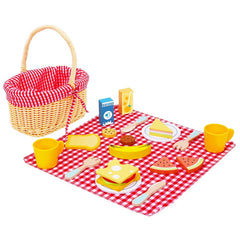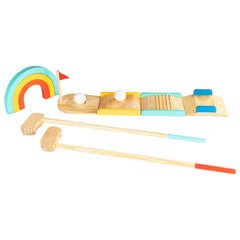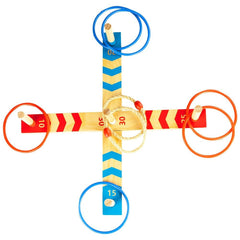How can you teach your tiny tots to express their emotions? How do you teach your toddler to empathise? How would you want your children to arrange their rooms when they grow up?
Can we ever teach any of these crucial life lessons? Yes! Parenting can be challenging, but now you can relax. We offer a variety of wooden toys that effectively teach skills as essential as reading and writing. Perhaps they even surpass expectations. Our wooden dollhouses teach life skills to your curious kiddo as they immerse themselves in the joy of playing with realistic dolls, miniature furniture, and adorable accessories.
Once upon a time, wooden dollhouses…
Long ago, people crafted 'baby houses' to teach young girls their domestic duties and roles. These miniature houses had started out as symbols of wealth and privilege. In the olden days, elaborate dollhouses were replicas of real mansions. In those days, dollhouses catered to the interests of adults rather than children. When ladies would go on long journeys, their treasured dollhouses were dismantled and packed so that the ladies could display their mansions even while holidaying far away from home.
Petronella Dunois, a Dutch art collector, owned a wooden dollhouse. Housed in the Rijksmuseum in Amsterdam, this wooden dollhouse dates back to the 16th century.
Later, ‘baby houses’ became a method to teach duties and social roles to young girls to prepare them for their roles in life as adults. Soon, toy manufacturers realised the potential of dollhouses as useful and educational toys.
Wooden dollhouses—miniature art pieces
While toys are meant to keep your active little one entertained and out of mischief, dollhouses are definitely more than mere playthings. Back in the day, dollhouses had authentic pieces of handcrafted furniture, porcelain crockery pieces, hand-embroidered upholstery, and well-kept gardens, too. These wooden dollhouses were places of honour in the homes of the wealthy. Rich gentry often commissioned the finest craftsmen to design and create elaborate mini mansions. Are you aware that some patrons even went so far as to commission artworks for their dollhouses? Princess Marie Louise installed 750 artworks, such as paintings, drawings, prints, and engravings made by leading artists, including Paul Nash and Adrian Scott Stokes, along with original murals painted by the famous illustrator Edmund Dulac.
This is the dining room of the famous Queen Mary's dollhouse, which is celebrating its 100th year of existence. Leading British architect Sir Edwin Lutyens crafted it between 1921 and 1924. More than 1,500 artists, craftspeople, and manufacturers of the early 20th century crafted this work of art for Queen Mary, consort of King George V.
Wooden dollhouses—Building EQ in young children
You have invested in developing the IQ of your darlings. But what are you doing to develop EQ in your children?
Emotional intelligence, better known as emotional quotient, is as important as or perhaps more essential than IQ for facing life and its myriad challenges. Emotional intelligence refers to the capacity of a person’s brain to perceive, interpret, control, and evaluate one’s emotions. EQ also includes the ability to understand and respond appropriately to others' emotions.
Here is where wooden dollhouses become an instrument of teaching and learning. Wooden dollhouses are an effective and entertaining way to develop the emotional intelligence of children. Wooden dollhouses provide a healthy outlet for expressing a child’s innermost feelings. While playing with characters in their dollhouse, children may project their own emotions. This will help parents identify their child’s moods as well as give children a safe space to vent their feelings.
Since rooms inside a wooden dollhouse are just as real as those in one’s own home, the dollhouse becomes a perfect stage to mimic real-life observations and mundane routines. Children can enact scenes from a busy kitchen or spend some quiet time in the study. The best part is that young kids can play with wooden dollhouses on their own or with friends.
Role-playing games in wooden dollhouses help children grasp concepts in running a household and develop their spatial reasoning capacity. Placing wooden furniture or wooden doll characters develops the fine motor skills of young children.
Fuelling creativity through wooden dollhouses
There is infinite space for creativity while playing with wooden dollhouses. Your child’s imagination knows no limits while playing different games and while decorating a wooden dollhouse using one’s own handmade accessories.
Simulating real-life events is the common role-play activity that allows children to process their understanding of the world around them. Birthday parties, packing for a holiday, a decluttering session, or even mundane activities like getting ready for school are engrossing dollhouse games.
If you are shifting houses, your young ones may find the change to be difficult. Here is where a wooden dollhouse can be a therapist! While enacting house shifting using dolls and the wooden dollhouse, children can project their own confused emotions and try to resolve them. Observing your child while they play with their wooden dollhouses can give you insights into their emotional state.
Out-of-the-box ideas
However, parents or primary carers can enhance the fun of wooden dollhouses by devising innovative themes. For instance, do you want your wooden dollhouse to be the scene for a meeting of the Avengers? Or perhaps the wooden dollhouse in your home is the venue for a fairy’s birthday party! Now that the world has experienced a pandemic, one can also enact a lockdown situation in a wooden dollhouse, which can become a wonderful coping mechanism for young children.
The best part is that moving the position of a wooden dollhouse often makes it more interesting. Shift the wooden dollhouse from its normal space if you can do so. Just as in the case of any toy, moving a wooden dollhouse to a different setting (perhaps placing it on a low table or taking it out to the backyard) can make it more exciting for young children. Adding new elements is yet another creative way to make a wooden dollhouse a whole new toy set. Encourage your kiddos to build roads with tape lines and to create parking spaces. These tasks will also mean adding their car collection to the scenario. New characters, new pieces of furniture, Christmas lights, and new accessories—all these add to the classic charm of a wooden dollhouse. Adding other wooden toy sets like the wooden play workbench or the wooden BBQ grill set makes playdates memorable and can entertain children for hours on end.
These are effective games that help to instil social skills, teach positive habits, and develop language skills in toddlers as well as in young children. While playing with different doll characters, children learn to see a situation from different perspectives. They gain empathy and an understanding of the repercussions of their actions through wooden dollhouse simulations.
Decorating wooden dollhouses
Decorating or redoing a wooden dollhouse releases the creativity of children and adults alike. Encourage your budding artists to create miniature artwork for their wooden dollhouse, drawing inspiration from classic wooden dollhouses. Children can paint murals or make tiny watercolour paintings to hang up on the walls of their wooden dollhouses. Making paper flowers to brighten up a wooden dollhouse is a wonderful activity that develops hand-eye coordination along with empowering children to make aesthetic decisions.
Painting a wooden dollhouse is not only a fun activity but also an important aspect of taking care of wooden dollhouses. Dollhouses made of wood need to be maintained carefully, and adding a new coat of paint refreshes the set while allowing your young artist to control the whole process.
Celebrating festivals in wooden dollhouses
Traditions allow us to decorate wooden dollhouses for all festivals. The practice is a wonderful way to introduce different cultures and customs to young children. Light up your wooden dollhouse not only for Christmas but also for other festivals. Each of these festivals requires different adornments for wooden dollhouses and teaches aspects of foreign customs in a delightful way.
Independent thinking and tackling problems in wooden dollhouses
No matter what the game may be, wooden dollhouses offer a multitude of ways to foster independent thinking. Young children learn to think independently, come up with creative ideas, and solve issues that may crop up while managing their wooden dollhouses.
Moving furniture around a wooden dollhouse instills the ability to visualise and improve the relationship between objects in a given space. Children have to think about the best possible space to add a piece of furniture or an accessory in a wooden dollhouse. This knack for spatial reasoning lays a foundation for pursuing STEM subjects and visual arts in the future.
Rearranging furniture or decluttering a wooden dollhouse can go a long way in helping children keep their own rooms and living spaces clean. Parents can teach kids to tidy up by arranging miniature furniture and possessions neatly. Children thus become more responsible for their rooms and can understand the difficulties in managing a home efficiently.
While enacting a quarantine scenario in a wooden dollhouse, children can understand the difficult aspects of isolation. Children will have to devise innovative solutions, enabling parents to work peacefully from home!
Open-ended play
The variety and quantity of games one can play with wooden dollhouses are limitless. There are no strict guidelines for games in a wooden dollhouse. Wooden dollhouses are equally captivating for a child who wants to spend time alone as well as for a group of friends in a classroom or on a play date. There is no age limit for playing with wooden dollhouses. While young kids may only be able to mimic real-life interactions, older kids find an outlet for creative flights of fantasy in wooden dollhouses.
A wooden dollhouse is an investment that yields results in a multitude of ways, the most important being the significant reduction of screen time. Playing games in wooden dollhouses is a joyful activity that can go on for any length of time. In fact, siblings may continue role-play sessions over a span of days. For example, Christmas can begin with the celebration of Advent by changing the décor each day in wooden dollhouses and then culminate in a grand celebration.
Taking care of wooden dollhouses
Just like in the past, people can pass down wooden dollhouses as heirlooms. A well-maintained wooden dollhouse will serve as a beloved toy set for many years to come. The most famous wooden dollhouses have lasted for centuries.
It is important to clean wooden dollhouses regularly. Use a soft cloth to wipe dust and dirt away. In cases of accumulated dirt, use an eraser to wipe away the grime on wooden dollhouses. Help your little ones clean, dust, and maintain their wooden dollhouses. Using chemical cleaning agents is unnecessary and harmful.
Wooden dollhouses are a perfect way to teach children the importance of maintaining accessories and furniture. After a long session of energetic and imaginative playing, it is vital to store the wooden furniture and accessories carefully. Encourage children to count their wooden accessories and cut out old clothes to create a protective covering for furniture. The activity is another lesson in maintenance and also teaches children to respect pieces of furniture in their homes and schools.
Dusting or cleaning dollhouses helps in tackling similar chores around the home as children grow up. Boys and girls learn to ‘see’ the tasks that their parents complete around the house and gradually learn to clean and declutter their spaces independently.
Repairs
If there are any damaged parts or loose components in a wooden dollhouse, it is vital to repair them immediately. If there are instructions for repairs given by the manufacturer, follow them carefully.
Parents can get in touch with the company’s customer service department for resolution of any issues that crop up in wooden dollhouses.
The perfect gift
Children will cherish wooden dollhouses as the best gift. Wooden dollhouses set the stage for creating wonderful memories that will last a lifetime. To find more gifts for your kids, then visit here: https://barnshenn.co.uk/collections/gift-sets





